
Developing a compliant, reader-friendly proposal outline is a critical first step toward creating a winning proposal.
Proposal outlines identify the major sections and subsections of a proposal in numerical order. The outline helps writers organize their ideas and stay on topic. It also helps the proposal manager ensure all required topics are addressed.
Proposals are complicated, involving many parts. For more than two decades in the proposal business, I have seen many clients struggle with getting the outline right. I have witnessed disagreements, false starts, and wild scrambles to completely re-do the outline shortly before the proposal is due.
I have seen a variety of approaches to the outline. Some folks start with the solicitation statement of work (SOW) and then weave in other proposal requirements. Others base it on key features of the proposed solution. Some build it around the evaluation factors, while others start with the solicitation instructions. One thing I have discovered is that when it comes to creating the outline, the order of operations matters.
How you start building the outline helps in avoiding what can be a massive effort to rewrite, disassemble, and reassemble the outline until it’s right.
In this article, I use the analogy of putting together a decorative tree to help you understand where to start and how to develop the proposal outline based on solicitation instructions, evaluation criteria, and the SOW. 
1. Build the Tree
The proposal instructions, evaluation criteria, and SOW would all mirror each other in an ideal world—and it would be easy to create a straightforward outline.
However, often, there are disconnects or similar items presented in a different order between the instructions, evaluation criteria, and SOW.
Getting Started
Just as we would assemble the basic structure (e.g., the base of the trunk and branches) of a decorative tree before adding lights and ornaments, our first step in the outlining process is to build the foundation following the proposal instructions, which typically appear in Section L of the solicitation.
In doing so, it is important to provide section titles that align with the instructions, with clear traceability, using numbered headings and subheadings with brackets or parenthesis to reference back to the instructions. This structuring makes it easy for the evaluator to determine that the proposal structure follows the instructions.
For illustrative purposes, we are going to build an outline for a hypothetical subsection of a proposal, the Management Approach for Contract XYZ. The table below provides an example of the foundation for our Management Approach outline, with the proposal instructions in the left column and the corresponding outline with references back to the instructions in the right column.
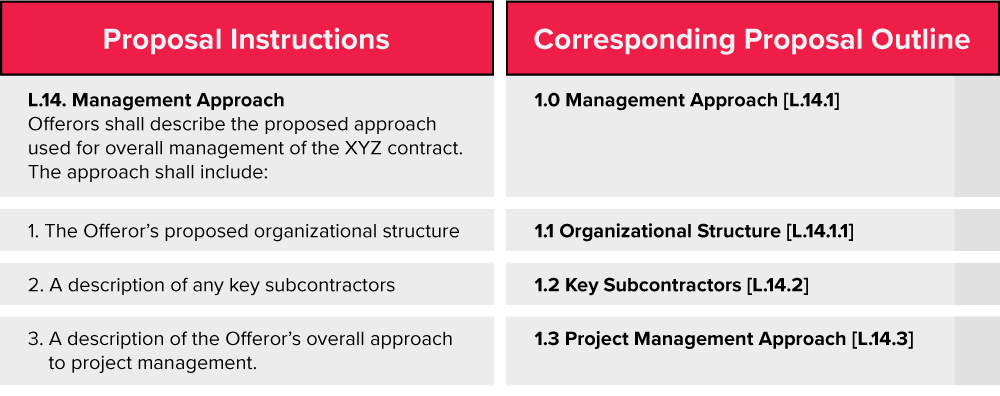
The figure below depicts our decorative tree structure for the basic outline.
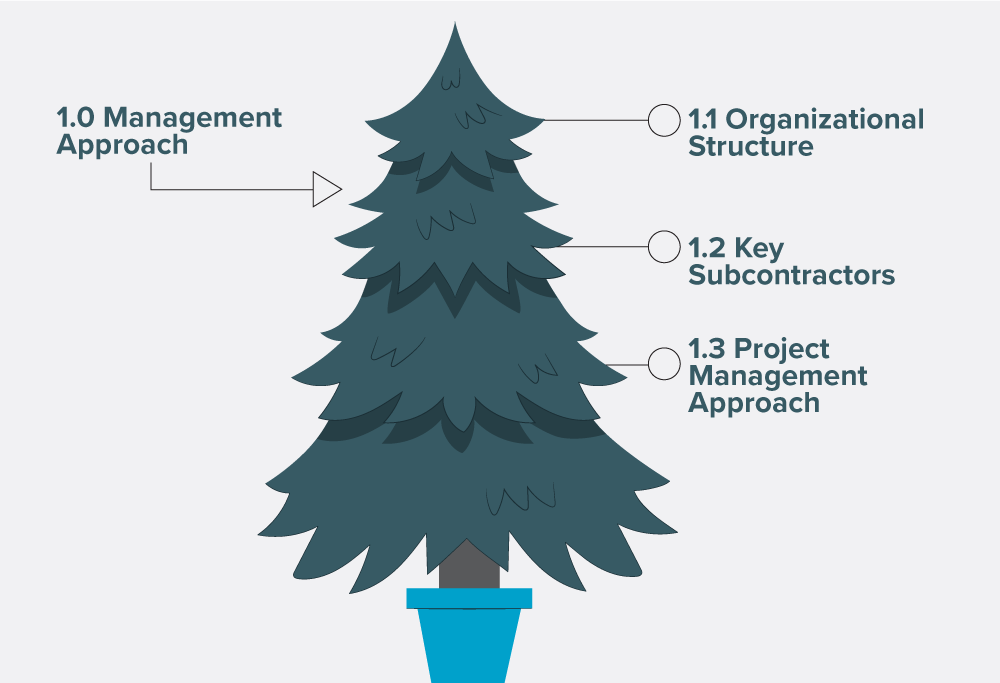
Avoiding Common Pitfalls
The most common outlining mistake I see is starting the outline based on the SOW and then trying to weave in the instructions. Since the SOW is typically much longer and more detailed than the instructions, the results from this approach can be disastrous, like trying to string lights and place ornaments on tree parts that are not yet assembled—in short, a tangled mess, and difficult to fix.
To avoid competing outlines, do one thing at a time and start with the solicitation instructions.
It’s also important that evaluators can compare apples to apples when evaluating proposals from competing firms—another reason to follow the instructions exactly and start with the instructions first.
2. Weave in the Evaluation Criteria
Now that we have built our tree, it’s time to add the lights.
As stated previously, in an ideal world, the evaluation criteria will mirror the instructions exactly. Sadly, this is often not the case with Government solicitations, as the Government typically assigns multiple writers to develop a solicitation—resulting in disconnects between solicitation sections. In the absence of a one-to-one correspondence between the instructions and evaluation factors, we will need to weave in parts of the evaluation criteria that do not match the instructions.
Again, let’s make it easy for the evaluator and provide traceability to the evaluation criteria. To do this, we can use numbered headings and subheadings. The table below shows our updated outline with the evaluation factors added in the middle column in green shading.
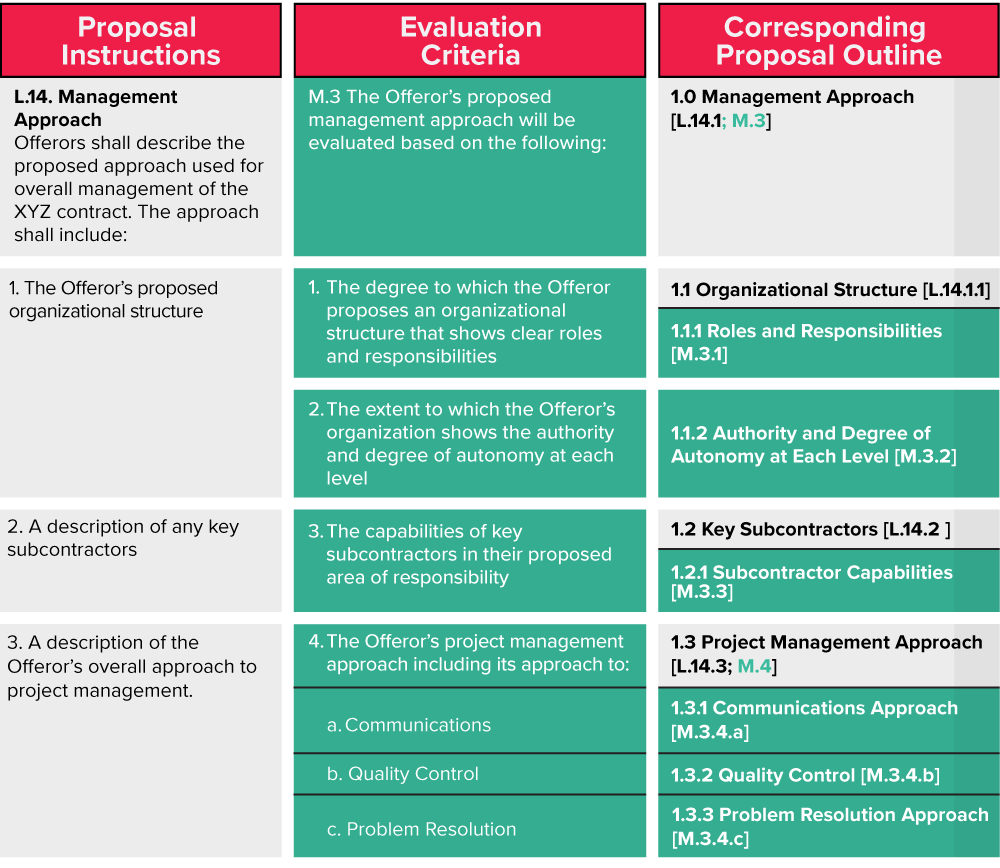
The figure below depicts our decorative tree structure for the basic outline, with the lights added to reflect the evaluation criteria.
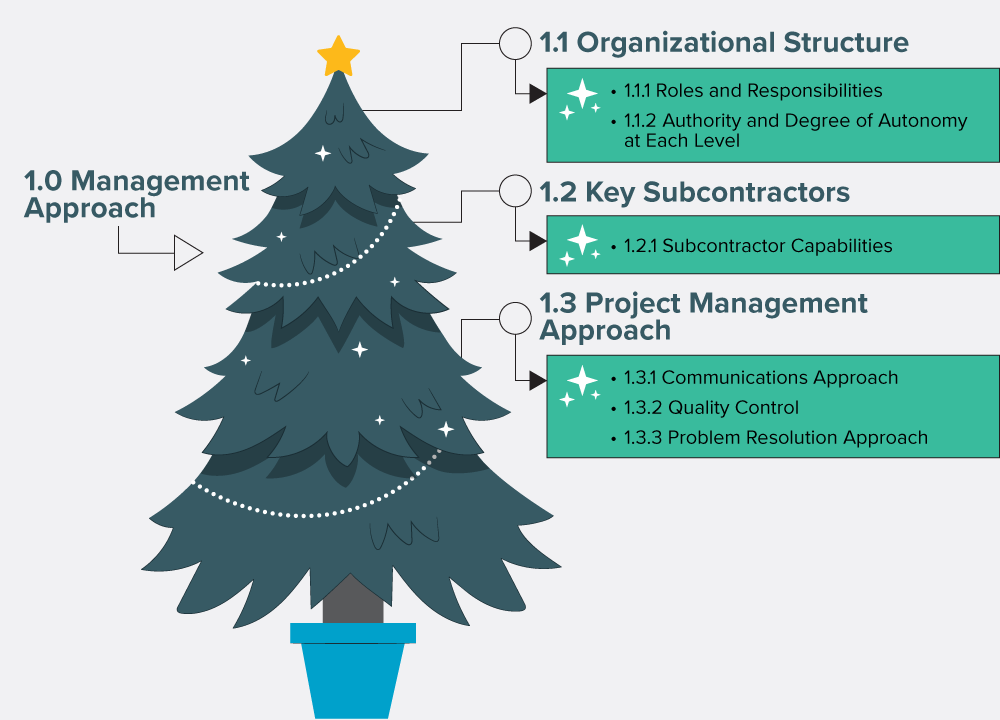
3. Weave in the SOW
Next, we add our ornaments. Before we do so, let’s get one thing straight. There is a common misconception that the SOW lays out how the proposal requirements should be organized. This is false.
The purpose of the SOW is to define the work the successful offeror is contractually obligated to perform after the contract award. Is it a good idea to include major elements of the SOW in the outline? Usually, the answer is yes, as this allows us to show that we tailor our approach to the specific work required. However, there are cases where the solicitation imposes strict page limits, and the instructions call for a more narrow, focused response.
Continuing with our example, let's imagine the SOW includes the following elements related to the Management Approach:
- SOW C.4.4 Key Personnel
- SOW C.4.5 Subcontractor Workshare
- SOW C.4.6 Deliverables
- SOW C.4.7 Communications
- SOW C.4.8 Risk Management
Because the order of the SOW differs from the order of the instructions and evaluation factors, we will need to map in parts of the SOW to fit within our overall outline. Again, help the evaluator out and provide traceability to numbered sections of the SOW (if applicable). The table below shows our updated outline with the SOW areas added in blue shading.
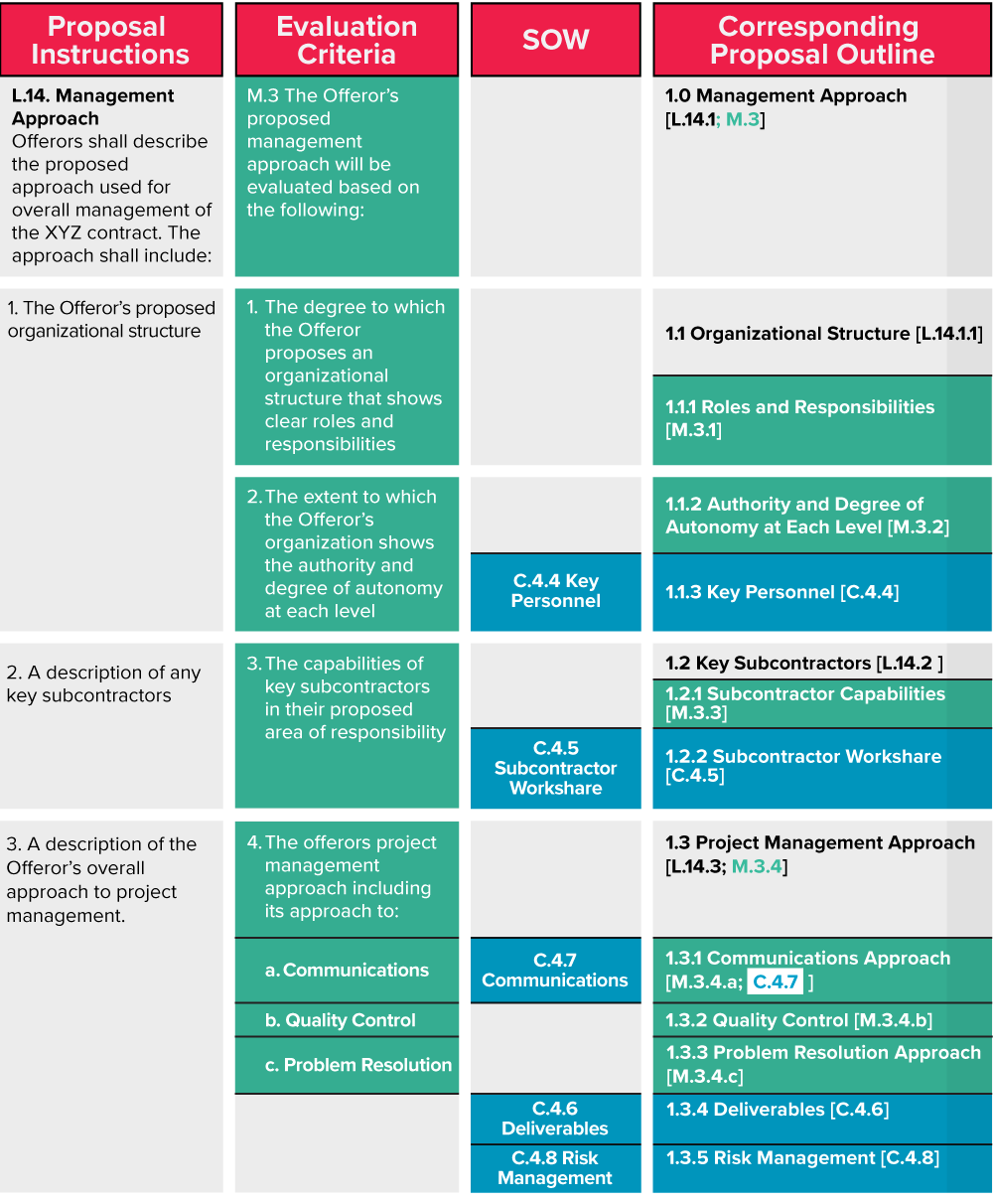
4. Putting it All Together
The figure below depicts our completed decorative tree, including the basic outline plus lights to reflect the evaluation criteria and ornaments to reflect the SOW.

Traditional View of the Proposal Outline
We have built our decorative tree as a vehicle to illustrate how we start with the basics and add in other elements as we build the outline. The table below shows the tree converted to a traditional proposal outline with RFP references included to ensure all requirements are addressed.
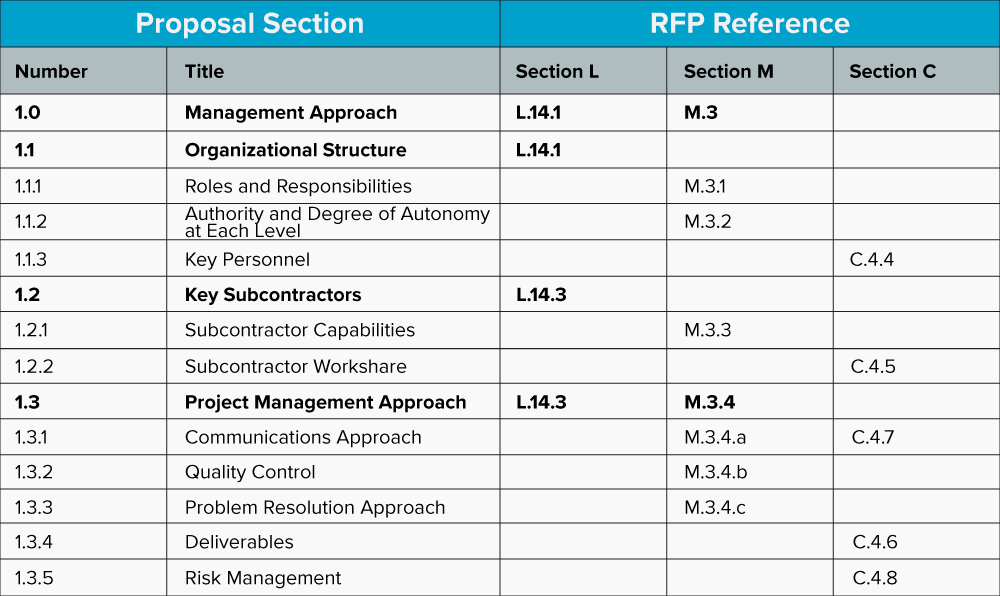
5. Tips for Minimizing Revisions
By spending time upfront getting the outline right, there will be fewer revisions later as the proposal content is developed. To further minimize the potential for major changes down the road, as a best practice, the Proposal Manager (or whoever is assigned to create the outline) should vet the first draft with key decision-makers before publishing the outline for the team. Some large organizations even require a formal quality control review of the outline before it is published. Doing this accomplishes two things: first, it’s a great way to get buy-in from the team; second, additional eyes often produce beneficial comments that can improve the outline.
It’s best to aim for no revisions once the outline is published. However, it is important to maintain a degree of flexibility—especially with minor tweaks the writers or reviewers may suggest as the outline is fleshed out and the narrative developed. For example, a first instinct in developing the outline to incorporate SOW elements may be to use numbered headings. However, the result may be multiple headings that map to a single solution, and it may make more sense to use a table or graphic with traceability to the SOW element to reduce page count, make the content clearer, and minimize repetition.
Conclusion
A solid outline is crucial to developing a strong proposal because of its role in demonstrating compliance with proposal requirements and the offeror’s ability to follow basic instructions. Order of operations is key—you would not build a decorative tree during the holidays by putting ornaments and lights on tree parts that are not yet assembled.
Following this outline guidance, you will create well-organized proposals that are easy to read, easy to score, and tailored to the SOW, increasing your win probability.








